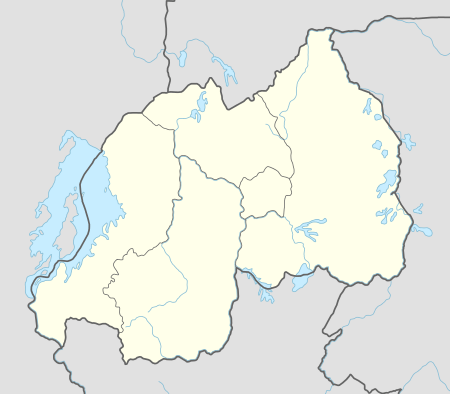Nyundo, Rubavu
| Nyundo | |
|---|---|
|
Nyundo mission in 1901 | |
 Nyundo | |
| Coordinates: RW 1°42′02″S 29°19′39″E / 1.700571°S 29.327488°ECoordinates: RW 1°42′02″S 29°19′39″E / 1.700571°S 29.327488°E | |
| Country | Rwanda |
| Province | Western |
| District | Rubavu |
| Sector | Nyundo |
| Climate | Aw |
Nyundo is a community in the Rubavu District of Western Province, Rwanda, on the Sebeya River to the east of Gisenyi. It is the location of one of the first Catholic missions to be established in Rwanda, and today is the headquarters of the Roman Catholic Diocese of Nyundo.
Location
Nyundo is in Kanama commune, beside the Rubavu commune, and contains a seminary, schools and the residence of the bishop.[1] It is about 12 kilometres (7.5 mi) to the east of Gisenyi, which is on the northeast shore of Lake Kivu.
Early years
German forces occupied Rwanda in 1897.[2] In 1899 the White Fathers missionary John Joseph Hirth traveled to that country.[3] There he tried to develop a relationship with King Yuhi Musinga. Hirth gained permission to found the first Catholic missions in Rwanda at Save, Zaza and Nyundo between 1900 and 1901. The church felt that if the king and the Tutsi ruling class of Rwanda were converted, the rest of the population would automatically accept the Catholic faith, so they focused their effort on the Tutsis.[4]
The Nyundo mission was founded on 4 April 1901. The German colonial authority established an important base at Kisenyi, in alliance with the Tutsi elite, and the missionaries at Nyundo found themselves obliged to take the side of the Tutsis. When Hutu Christians took action against Tutsi exactions, the priests were blamed for causing this insubordination.[5] The local Tutsi rulers also resented the missionaries, with their growing power and demands.[6]
The mission was badly damaged during World War I, since it was close to the important defensive line between German and Belgian territory. The German forces lived off the land, and when they retreated in 1916 they first destroyed banana groves that could provide supplies to their opponents. The local people, who had gone into hiding, were unable to sow their crops. When the priests returned they were able to feed about two hundred people at the mission, but many more starved.[7] Malnutrition was followed by outbreaks of smallpox, cerebrospinal menengitis and dysentery. Despite large-scale vaccinations by the fathers, more than two thousand people died in July 1918 alone.[8]
Later history
The Vicariate of Nyundo was erected on 14 February 1952, elevated to a diocese five years later. The diocese covers most of the northern part of Western Province, including the districts of Ngororero, Rutsiro, Rubavu, Karongi and parts of Nyabihu and Nyamasheke. Its first bishop was Aloys Bigirumwami.[9] He was first African Bishop to be appointed in the Belgian colonies (Rwanda, Burundi and Congo) and sixth African to be made a Catholic Bishop.[10]
There was an outbreak of violence against Tutsis at Nyundo during the Rwandan Genocide. The morning after the death of President Juvénal Habyarimana, on 7 April 1994 a number of Tutsi families came to Nyundo for safety. A large, hostile and armed crowd arrived, and the killing began, including women and children who took refuge in the chapel. The bishop, Mr. Wenceslas Kalibushi, was taken to Gisenyi and was later released at the request of the Vatican.[1] A genocide memorial was later established with the graves of about 800 people, between a school and a seminary.[11] Floods in 2012 damaged the graves, and a new location had to be found for the memorial.[12]
Orphanage
The "Noël de Nyundo" orphanage was first established in 1954 at Muramba, in Kingogo Region, to receive children whose mothers had died in childbirth. Until then they had traditionally been buried with their mother. A new building at Nyundo was authorized in 1964.[13] It admitted its first children on Christmas 1966. During the disturbances of 1994 the children had to take refuge for a few months in Goma, in the Democratic Republic of the Congo. The orphanage was badly damaged.[14]
As of 2012 the orphanage, one of the largest in the country, was home to 189 children under eighteen and to 254 adults, including fourteen with mental disabilities. The adults had entered the orphanage as children and had difficulty learning how to cope outside.[15]
References
Citations
- 1 2 Melvern 2006, p. 170.
- ↑ Sundkler & Steed 2000, p. 597.
- ↑ Adekunle 2007.
- ↑ Adekunle 2007, p. 33.
- ↑ Linden & Linden 1977, p. 75.
- ↑ Linden & Linden 1977, p. 218.
- ↑ Linden & Linden 1977, p. 127.
- ↑ Linden & Linden 1977, p. 128.
- ↑ Présentation: Diocese of Nyundo.
- ↑ Shimamungu 2009.
- ↑ Meierhenrich 2010.
- ↑ Way Forward...
- ↑ Historique: L'Orphelinat Noël.
- ↑ Michel 2011.
- ↑ Rutayisire 2012.
Sources
- Adekunle, Julius (2007). Culture and Customs of Rwanda. Greenwood Publishing Group. ISBN 978-0-313-33177-0. Retrieved 26 March 2013.
- "Historique". L'Orphelinat Noël. Retrieved 2013-04-02.
- Linden, Ian; Linden, Jane (1977). Church and revolution in Rwanda. Manchester University Press. ISBN 978-0-7190-0671-5. Retrieved 2013-04-02.
- Meierhenrich, Jens (2010). "Nyundo". Through a glass darkly. Retrieved 2013-04-02.
- Melvern, Linda (2006). Conspiracy to murder: the Rwandan genocide. Verso. ISBN 978-1-84467-542-5. Retrieved 2013-04-02.
- Michel (5 May 2011). "Des sanitaires rénovés à l'orphelinat Noël de Nyundo". Les Enfants Avant Tout. Retrieved 2013-04-02.
- "Présentation". Diocese of Nyundo. Retrieved 2013-04-02.
- Rutayisire, Pierre C. (19 September 2012). "Nyundo orphanage stuck with grown-up dependants". New Times. Retrieved 2013-04-02.
- Shimamungu, Eugène (27 May 2009). "Biographie de Mgr Aloys Bigirumwami". Editions Sources du Nil. Retrieved 2013-03-25.
- Sundkler, Bengt G. M.; Steed, Christopher (2000). A History of the Church in Africa. Cambridge University Press. p. 597. ISBN 978-0-521-58342-8. Retrieved 26 March 2013.
- "WAY FORWARD ON NYUNDO MEMORIAL SITE RELOCATION". National Commission for the Fight against Genocide. 19 March 2013. Retrieved 2013-04-02.
